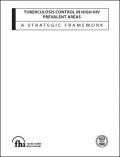Publications - Released in 2001
Tuberculosis (TB) continues to be one of the most important global public health threats. The World Health Organization (WHO) estimates that the incidence of TB increased by 5 percent between 1997 and 1999, from 8 million to 8.4 million new cases. African countries severely affected by the HIV epidemic experienced a 20 percent increase in the incidence of TB; this rise is largely responsible for the TB increase globally.
The relationship between TB and HIV has been recognized since the early days of the HIV epidemic. Today HIV is known to be an important risk factor, contributing to the development of active TB from latent TB infection. A person co-infected with TB (positive PPD skin test) and HIV faces a five percent to 16 percent annual risk of developing active TB disease. HIV also makes individuals with a recent TB infection more likely to progress rapidly to active TB disease. WHO estimates that more than 10 million people worldwide live co-infected with TB and HIV, more than two-thirds of whom are in sub-Saharan Africa.
Downloads
Organizations
- FHI 360 (Family Health International)
- United States Agency for International Development (USAID)






